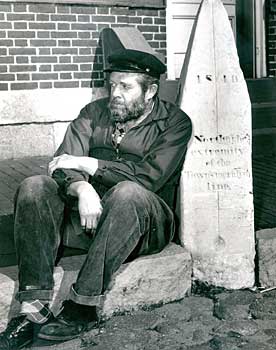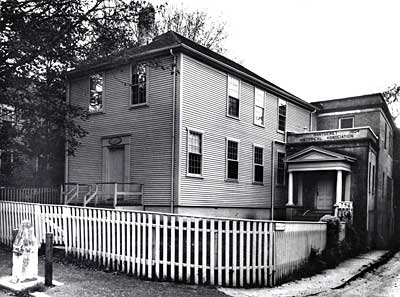William Mitchell’s Meridian Stones
by Frances Karttunen
At the head of Main Street stands the red brick Pacific National Bank, built in 1818. Rising up from the sidewalk on the south side of the bank is a waist-high white stone obelisk inscribed with the words: “1840. Northern extremity of the Town’s meridian line.”
Across the street from the north meridian stone, Fair Street runs south past the Nantucket Historical Association’s Research Library, The Quaker Meeting House, St. Paul’s Episcopal Church, and the Ship’s Inn. Right in front of the Meeting House and the research library sits an identical obelisk, flanked on either side by protective posts to ward off parking cars. This one is inscribed: “1840. Southern extremity of the Town’s meridian line.” These two stones were set by William Mitchell during the time he and his family lived upstairs in the bank building.
An article was placed in the warrant of the 1840 Town Meeting “To see if the town will cause a meridian line to be established for public use and defined by suitable bounds.” The Town Meeting was convinced that this public use, whatever it might have been, was worthwhile and voted to erect the markers, provided the project could be carried out for no more than $75. Apparently that was not a problem, and the little obelisks sit by the curbs to this day.
 When he seated the stones, William Mitchell had been employed as secretary of the bank for seven years. As a sideline, he set chronometers for vessels leaving Nantucket on long voyages. For this reason, Nantucketers came to think of the two meridian stones as a tool for determining precise time, although nobody could account for how they might have worked.
When he seated the stones, William Mitchell had been employed as secretary of the bank for seven years. As a sideline, he set chronometers for vessels leaving Nantucket on long voyages. For this reason, Nantucketers came to think of the two meridian stones as a tool for determining precise time, although nobody could account for how they might have worked.
There was a reason for this, as Vladimir Strelnitski and his associates at Nantucket’s Maria Mitchell Observatory determined in 2002. As they wrote in their report, “Everything we know about the procedures for precise determination of time in the middle of the 19th century fails to support the speculation about the use of meridian stones for rating chronometers.”
Then what was their function, worth as much as $75 to the Town of Nantucket? Mitchell had another sideline; he was a surveyor, and in 1838 he had produced a map of Nantucket including Tuckernuck. That project probably convinced him of the utility of a fixed meridian line for future projects in and around town. In those days before global positioning via satellites, surveying was done by compass and chain, and as we all know, or should know, Earth’s magnetic poles and its axis of rotation do not coincide. What’s more, the magnetic poles wander more than a little. Hence surveyors’ need for magnetic declination tables to determine true north from any particular spot on earth.
If one looks carefully at the north meridian stone, one sees a vertical line with a cup-shaped indentation at the bottom. (Erosion has pretty much obliterated the corresponding marks on the south stone.) Strelnitski and his fellow researchers state that the purpose of the line and indentation “was almost certainly made to use a plumb line.” So, the useful purpose of Mitchell’s meridian stones was to determine exact direction, not exact time.
Alas, when the Maria Mitchell team carried out measurements and calculations, they found that the stones are misaligned by a little over six inches. Could Mitchell have miscalculated? More likely the south stone—the one with protective guard posts—is no longer in its original position. At least once and probably twice it has been taken up to make way for construction and paving, and it probably is no longer exactly where William Mitchell put it.

Who was this William Mitchell, jack of all trades? A birthright Quaker, he was the son of a cooper who was also engaged in the oil and soap business. Despite getting off on the wrong foot in not one but two miserable private schools on the island, young William was headed for Harvard College. But, like more than a few Nantucket boys then and now, he balked and decided instead to stay on-island working for his father. In those days prior to even the notion of teaching certification, he somehow became a schoolmaster at eighteen, a job he returned to later in life. When the first Nantucket public school was established in 1827, self-educated William Mitchell was appointed principal!
His self-education included astronomy, and for a while he was Nantucket’s pre-eminent astronomer until he was surpassed by his daughter Maria. Encouraged by her father, she carried out systematic observations of the night sky with a telescope mounted on the roof of the bank building, calling her observations “sweeping.” One October evening in 1847, bored—it is said—at a family dinner party, Maria slipped away to the roof and discovered a comet. William recorded the position of her comet in his journal and reported it to Harvard College Observatory. Within a year Maria Mitchell had received a gold medal for her discovery from the King of Denmark and had been voted an Honorary Member of the American Academy of Arts and Sciences. This simultaneously launched her international fame as a scientist and eclipsed her modest father’s reputation.
William had married his childhood sweetheart Lydia Coleman in 1812, and Maria was one of ten brothers and sisters. William had to work three jobs at a time to maintain them all until they grew up and left the nest.
One by one the other young Mitchells (boys Andrew, Francis, William Forster and Henry; girls Sally, Anne, Phebe, and Kate) married and established homes of their own. In the wake of the Civil War, William Forster Mitchell spent time teaching in Freedmen’s schools in the South. When Andrew was disowned from Quaker Meeting for taking a non-Quaker wife, Maria notified the Meeting that her mind was not settled on religious matters, and she was disowned too, the two disownments recorded on the same page of the Quaker “Book of Objections.” Eventually William Mitchell himself, a deeply religious man, was also expelled from Meeting for attending other people’s religious observances.
Unlike her brothers and sisters, Maria remained unmarried and eventually was appointed Professor of Astronomy at Vassar College. By then William had lost his beloved Lydia, and he made his home with Maria to the end of his long life. At Vassar he was a favorite of his daughter’s students. In January, 1869, he wrote in his journal of a recent Christmas visit from five of these young women: “We had a cheery and jolly time of it. I almost forgot my age and my infirmities.” Four months after that jolly visit, he passed away at the age of seventy-seven.
A search in the Nantucket Historical Association’s online historic images database will lead to photographs of the Pacific National Bank (image number S1782); the north meridian stone (P763B) and the south meridian stone (F2887); the 1838 Mitchell map of Nantucket and Tuckernuck (S8015); and a photograph of William Mitchell as a venerable old man (P21775).
Frances Karttunen’s book, The Other Islanders: People Who Pulled Nantucket’s Oars, is available at bookstores and from Spinner Publications, New Bedford. Look for Law and Disorder in Old Nantucket in bookstores this summer.